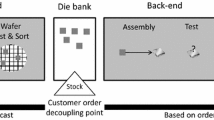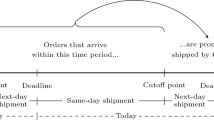Abstract
The available to promise (ATP) function has increasingly attracted the attention of the supply chain management research community as a tool for enhancing the responsiveness of order promising and the reliability of order fulfillment. It directly links available resources, including both material and capacity, with customer orders and, thus, affects the overall performance of a supply chain. In this paper, a mixed integer programming (MIP) model for a quantity and due date quoting ATP mechanism is presented. This model can provide individual order delivery dates for a batch of customer orders that arrive within a predefined batching interval. In addition, the model allows customized configurations and takes into account a variety of realistic supply chain constraints, such as material compatibility, substitution preferences, capacity utilization, and material reserve. We conclude this paper with sensitivity analysis of performance impacts with respect to batching interval size and material reserve policy.
Similar content being viewed by others
References
APICS. Dictionary, 6th ed. Falls Church, VA: American Production and Inventory Control Society, 1987.
Arntzen B, Brown G, Harrison T, Trafton L. Global supply chain management at digital equipment corporation. Interfaces 1995;25(1):69–93.
Balakrishnan A, Geunes J. Requirements planning with substitutions: Exploring bill-of-materials flexibility in production planning. Manufacturing & Service Operations Management 2000;2(2):166–185.
Ball MO, Chen C-Y, Zhao Z-Y. Material compatibility constraints for make-to-order production planning. Operations Research Letters, submitted. Internet: bmgt1-notes.umd.edu/faculty/km.nsf/.
Bitran GR, Mondschein SV. An application of yield management to the hotel industry considering multiple day stays. Operations Research 1995;43(3):427–443.
Chen C-Y, Zhao Z-Y, Ball MO. A model for batch advanced available-to-promise to be published in Production and Operations Management.
Cheng TCE, Gupta MC. Survey of scheduling research involving due date determination decisions. European Journal of Operational Research 1989;38(2):156–166.
Duenyas I, Hopp WJ. Quoting customer lead times. Management Science 1995;41(1):43–57.
eB2X Inc. Why promising orders? How strategic order promising helps supply chains compete in the new economy. 2000 [On-line]. Available Internet: www.eb2x.com.
Fordyce KJ, Sullivan GA. Supply chain management, decision technology, and e-business information technology at IBM microelectronics. MicroNews 1999;5(4) [On-line]. Available Internet: chips.ibm.com/micronews.
Hariharan R, Zipkin P. Customer-order information, leadtimes, and inventories. Management Science 1995;41(10):1599–1607.
Hegedus MG, Hopp WJ. Due date setting with supply constraints in systems using MRP. Computers & Industrial Engineering 2001;39(3/4):293–305.
Hill S Jr. Trade exchanges & order promising: Can internet trade exchanges deliver order promising capability? 2000 [On-line].Available Internet: www.manufacturingsystems.com.
Hopp WJ, Sturgis ML. Quoting manufacturing due dates subject to a service level constraint. IIE Transactions 2000;32(9):771–784.
Johnson LA, Montgomery DC. Operations Research in Production Planning, Scheduling, and Inventory Control. NewYork,NY: John Wiley & Sons, Inc, 1974.
Kilger C, Schneeweiss L. Demand fulfillment andATP. In: Stadtler H, Kilger C, eds. Supply ChainManagement and Advanced Planning: Concepts, Models, Software and Case Studies. Berlin, Germany: Springer, 2000:135–148.
Lee HL, Billington C. The evolution of supply-chainmanagement models and practice at Hewlett-Packard. Interfaces 1995;25(5):43–63.
Manugistics Inc. Delivering on customer promises—A critical component for eBusiness success. 2000 [On-line]. Available Internet: www.manugistics.com.
Mcfeely DJ, Simpson WP III, Simoms JV Jr. Scheduling to achieve multiple criteria in an air force depot CNC machine shop. Production and Inventory Management Journal 1997;38(1):72–78.
Park M-W, Kim Y-D. A branch and bound algorithm for a production scheduling problem in an assembly system under due date constraints. European Journal of Operational Research 2000;123(3):504–518.
Robinson AG, Dilts DM. OR & ERP: A match for the new millennium? OR/MS Today 1999;26(3):30–35.
SAP AG. Functions in detail—SAP advanced planner & optimizer: Global available-to-promise. 1999 [On-line]. Available Internet: www.sap.com.
Simchi-Levi D, Kaminsky P, Simchi-Levi E. Designing and Managing the Supply Chain: Concepts, Strategies, and Case Studies. New York, NY: Irwin/McGraw-Hill, 2000.
Subramanian J, Stidham S Jr, Lautenbacher CJ. Airline yield management with overbooking, cancellations, and no-shows. Transportation Science 1999;33(2):147–167.
Taylor SG, Plenert GJ. Finite capacity promising. Production and Inventory Management Journal 1999;40(3):50–56.
Thore SAO. Economic Logistics: The Optimization of Spatial and Sectoral Resource, Production, and Distribution Systems. New York, NY: Quorum Books, 1991.
Tsai C-H, Chang G-T, Li R-K. Integrating order release control with due-date assignment rules. International Journal of Production Research 1997;35(12):3379–3392.
Tsay AA, Nahmias S, Agrawal N. Modeling supply chain contracts: A review. In: Tayur S, Ganeshan R, Magazine M, eds. Quantitative Models for Supply Chain Management. Boston, MA: Kluwer Academic Publishers, 1998:299–336.
Ware N, Fogarty DW. Master schedule/master production schedule: The same or different? Production and Inventory Management Journal 1990;1:34–37.
Zweben M. Delivering on every promise: Real-time sales order promising of supply chain resources. APICS—The Performance Advantage 1996;6(3) [On-line]. Available Internet: www.apics.org/magazine.
Author information
Authors and Affiliations
Corresponding author
Rights and permissions
About this article
Cite this article
Chen, CY., Zhao, ZY. & Ball, M.O. Quantity and Due Date Quoting Available to Promise. Information Systems Frontiers 3, 477–488 (2001). https://doi.org/10.1023/A:1012837207691
Issue Date:
DOI: https://doi.org/10.1023/A:1012837207691




